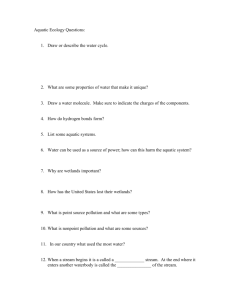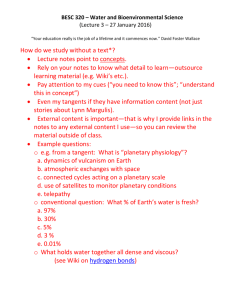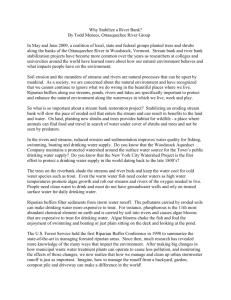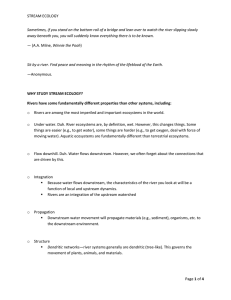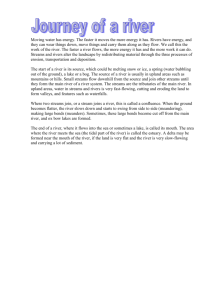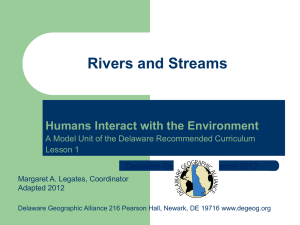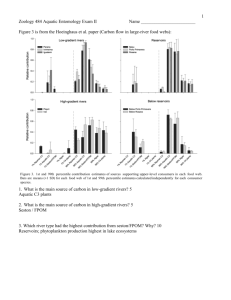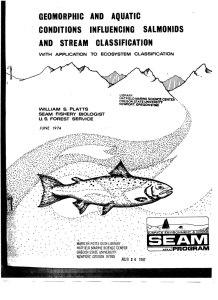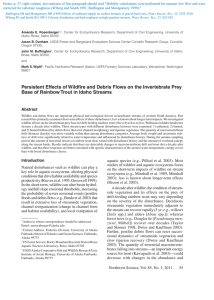document
advertisement
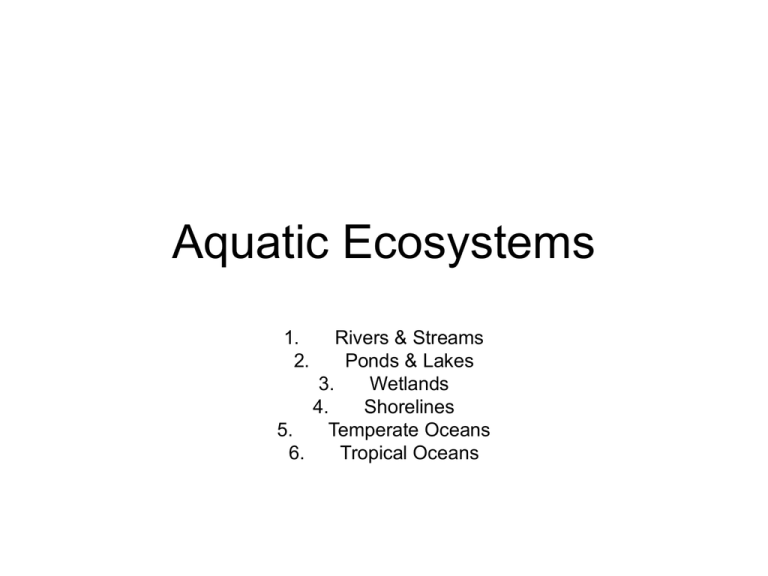
Aquatic Ecosystems 1. 2. Rivers & Streams Ponds & Lakes 3. Wetlands 4. Shorelines 5. Temperate Oceans 6. Tropical Oceans Rivers & Streams • Rivers and streams channel water across the land masses of earth from mountains to oceans. • Water not absorbed becomes surface water. If it follows a gradient to a stream it eventually flows to a larger river and then to the ocean. • They account for only .3% of earth’s surface. Rivers & Streams • Watersheds* It comes as no surprise that the widest rivers have the biggest watersheds. The Mississippi watershed drains about half the Midwest and eastern United States. • The Mississippi and Missouri river systems account for 3,740 miles in the United States. The Nile is the longest in the world at 4,145 miles. Rivers & Streams • Life is abundant in this ecosystem. Both plant and animals • Each aquatic community has a variety of plants which provide shelter and food for many of the animals living in the community, and add oxygen to the water. Some of these plants grow along the water's edge, such as pickerelweed. River /Stream Plants • EMERGENTSPlants that grow out of water are called emergents. Some emergents are: broadleaf arrowhead, named for the shape of its leaf, and soft rush. River /Stream Plants • FLOATING PLANTS Other aquatic plants have adapted so that their leaves float on the surface of the water. These plants, such as spatter dock (left), floating pondweeds (bottom left), and duckweed (bottom right), tend to occur in ponds and in backwaters of streams and rivers where there is little or no current. River /Stream Plants • SUBMERGENTS A third group of plants grow completely submerged under the surface of the water. The roots of this water milfoil (right) anchor it into the bottom of the pond. Coontail (below), also a submerged plant, is a bit different. Often it isn't rooted to the ground. River /Stream Critters Many of the animals which live in aquatic ecosystems rely on the plants for food. There are many insects living in and around bodies of water. Some of these insects live their adult lives as flying insects, like the dragonfly, but their larval stages are spent in the water. • dragonfly nymph River /Stream Critters • Damselfly The damselfly adult looks much like the dragonfly. However, it can be distinguished by the way it holds its wings when at rest. The dragonfly holds its wings out to the sides when resting, whereas the damselfly holds its wings together above it body. • damselfly nymph River /Stream Critters • Mayfly; are seen most often when they swarm for mating or come to lights at night. Adults generally do not eat, and live for only a few days. • nymph of the mayfly • most often found in clear streams. Its shape is flattened to resist the force of fast currents. These nymphs generally feed on detritus, or decaying matter, and algae. River /Stream Critters • Stonefly nymphs found under stones and amongst debris in clean, cool, running water and indicate good water quality. • Cranefly • feed on detritus, such as decaying leaves, which accumulates in ponds or backwater streams • DobsonflyMost dobsonfly species are nocturnal. Males of some species have mandibles which are tusklike. They can bite River /Stream Critters • Water Bugs Before diving below the surface of the water, the giant water bug captures a bubble of air which it takes underwater and uses for oxygen • The water scorpion is found in ponds and other still waters Water striders are found on the surface of still and slow moving waters. They glide over the water, using their long spiderlike legs with waxy hairs on the tip to stay on top of the water surface. They eat aquatic insects. Water Boatmen most common of the aquatic bugs .
